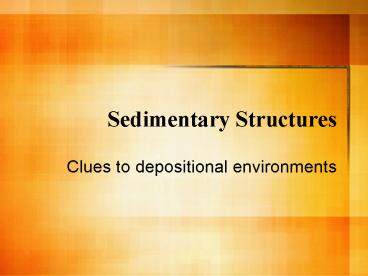Sedimentary Structures - PowerPoint PPT Presentation
1 / 8
Title:
Sedimentary Structures
Description:
Bedding - layering! Layering of sediments is common due to ... Cross-bedding (inside ... large scale cross-bedding in these sandstones (interpreted ... – PowerPoint PPT presentation
Number of Views:700
Avg rating:3.0/5.0
Title: Sedimentary Structures
1
Sedimentary Structures
- Clues to depositional environments
2
Bedding - layering!
- Layering of sediments is common due to episodic
deposition - In most cases the layers are close to horizontal
at the time of deposition - Layering may survive lithification
Loose sediment - Merrimack Valley
East Berlin formation - Holyoke
3
What does a geologist see?
Colorado River - Grand Canyon National Park, AZ
4
Ripple marks - indicate currents
Pyramid Lake, NV
Grand Canyon Natl. Park, AZ
- Ripples form on the surface of sediment (mud or
sand) over which a current of wind or water is
flowing - Current direction may be indicated by the
asymmetry of the ripples (steep side upstream)
5
Cross-bedding (inside ripples or dunes)
- Sediment layers on the front slope of a ripple or
dune will be inclined at the time of deposition - Current direction is indicated by the direction
of tilt of those cross-beds
Interior of ripples in outwash - NH
De Chelley sandstone - AZ
6
- Note large scale cross-bedding in these
sandstones (interpreted as old desert dunes,
lithified to stone!)
Canyon de Chelly, AZ
7
Mudcracks (drying of fine sediment)
In sediment, near Albany, NY
In mudstone, Glacier Natl. Park, MT
- Mudcracks form when wet, muddy sediment dries out
and shrinks - Other sediment may fill in the cracks, preserving
these features after lithification
8
Implications for environments?
- Bedding - episodic deposition, undisturbed
sediment (no burrowers) - Ripples marks - margins of streams, windy
environments (current of wind or water) - Cross-bedding - margins of streams, desert dunes
(similar to ripples - the cross-beds are inside!) - Mudcracks - seasonal lakes, margins of rivers or
lakes (occasional drying out of environment)































